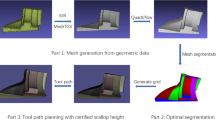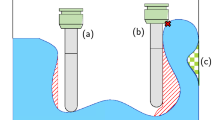Abstract
In this paper a new approach for manufacturing modified workpieces by milling is presented. In course of product development, several optimization iterations are often required, in which the shape of the workpiece is modified. Conventional method for manufacturing modified workpieces includes a time-consuming and error-prone step of reverse engineering, where the new CAD/CAM data is generated with respect to the measurement data of the manufactured workpiece. The new approach generates a continuous deformation function in order to approximate the discrete displacement vectors between the initial and the modified shapes, and applies this function on the original NC programs of the workpiece. Hence, it is possible to directly manufacture the modified shape. The process of reverse engineering can be eliminated so that manufacturing costs and the time from workpiece design to the production decrease significantly.







Similar content being viewed by others
References
Barr AH (1984) Global and local deformations of solid primitives. SIGGRAPH Comput Graph 18(3):21–30
Benko P, Kós G, Várady T, Andor L, Martin R (2002) Constrained fitting in reverse engineering. Computer Aided Geometric Design 19(3):173–205
Besl PJ, McKay ND (1992) A method for registration of 3-d shapes. IEEE Trans Pattern Anal Mach Intell 14(2):239–256
Biermann D, Surmann T, Sacharow A, Skutella M, Theile M (2008) Automated analysis of the form error caused by springback in metal sheet forming. In: Proceedings of the 3rd international conference on manufacturing engineering, Kallithea of Chalkidiki, Greece, pp 737–746
Caetano TS, McAuley JJ, Cheng L, Le QV, Smola AJ (2009) Learning graph matching. IEEE Trans Pattern Anal Mach Intell 31(6):1048–1058
Chen Y, Medioni G (1991) Object modeling by registration of multiple range images. IEEE Int Conf Robot Autom 3:2724–2729
Chikofsky EJ, Cross II JH (1990) Reverse engineering and design recovery: a taxonomy. IEEE Softw 7(1):13–17
Coquillart S (1990) Extended free-form deformation: a sculpturing tool for 3d geometric modeling. SIGGRAPH Comput Graph 24(4):187–196
Gan W, Wagoner RH (2004) Die design method for sheet springback. Int J Mech Sci 46(7):1097–113
Gelfand N, Mitra NJ, Guibas LJ, Pottmann H (2005) Robust global registration. In: Proceedings of the third eurographics symposium on geometry processing, Eurographics Association, pp 197–206
Griessmair J, Purgathofer W (1989) Deformation of solids with trivariate b-splines. In: Proceedings of eurographics, pp 137–148
Hoppe H, DeRose T, Duchamp T, McDonald J, Stuetzle W (1992) Surface reconstruction from unorganized points. In: SIGGRAPH ’92: Proceedings of the 19th annual conference on computer graphics and interactive techniques, ACM, New York, pp 71–78
Hsu WM, Hughes JF, Kaufman H (1992) Direct manipulation of free-form deformations. In: SIGGRAPH ’92: Proceedings of the 19th annual conference on computer graphics and interactive techniques, ACM, New York, pp 177–184
Hu SM, Zhang H, Tai CL, Sun JG (2001) Direct manipulation of ffd: efficient explicit solutions and decomposible multiple point constraints. Visual Comput 17(6):370–379
Lamousin HJ, Waggenspack WNJ (1994) Nurbs-based free-form deformations. IEEE Comput Graph Appl 14:59–65
Liu L, Zhang L, Xu Y, Gotsman C, Gortler SJ (2008) A local/global approach to mesh parameterization. Comput Graph Forum 27(5):1495–1504
Ma YL, Hewitt WT (2003) Point inversion and projection for nurbs curve and surface: control polygon approach. Comput Aided Geom Des 20(2):79–99
Noble RA, Clapworthy GJ (1999) Direct manipulation of surfaces using nurbs-based free-form deformations. In: Proceedings of the 1999 international conference on information visualisation, IEEE Computer Society, Washington, DC, pp 238–243
Piegl L, Tiller W (1997) The NURBS book (2nd ed). Springer-Verlag, New York
Press WH, Teukolsky SA, Vetterling WT, Flannery BP (2002) Numerical recipes in C++: the art of scientific computing. Cambridge University Press, Cambridge
Sarraga RF (2004) Modifying cad/cam surfaces according to displacements prescribed at a finite set of points. Comput Aided Des 36(4):343–349
Sederberg TW, Parry SR (1986) Free-form deformation of solid geometric models. SIGGRAPH Comput Graph 20(4):151–160
Vanco M, Brunnett G (2002) Direct segmentation for reverse engineering. In: Proceedings of the first international symposium on cyber worlds (CW’02), IEEE Computer Society, Washington, DC, pp 24–37
Várady T, Martin RR, Cox J (1997) Reverse engineering of geometric models—an introduction. Comput Aided Des 29(4):255–268
Weiher J, Rietman B, Kos K, Ohnimus S, Petzoldt M (2004) Controlling springback with compensation strategies. In: American institute of physics conference series, vol 712, pp 1011–1015
Weinert K, Surmann T (2006) Modeling of surface structures resulting from vibrating milling tools. Production Eng Res Dev 13(2):133–138
Acknowledgments
This work has been funded by the Collaborative Research Center “3D-Surface Engineering” (SFB 708) of the German Research Foundation (DFG).
Author information
Authors and Affiliations
Corresponding author
Rights and permissions
About this article
Cite this article
Biermann, D., Sacharow, A., Surmann, T. et al. Direct free-form deformation of NC programs for surface reconstruction and form-error compensation. Prod. Eng. Res. Devel. 4, 501–507 (2010). https://doi.org/10.1007/s11740-010-0260-3
Received:
Accepted:
Published:
Issue Date:
DOI: https://doi.org/10.1007/s11740-010-0260-3




